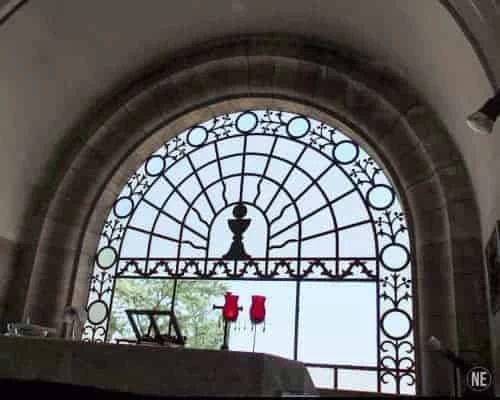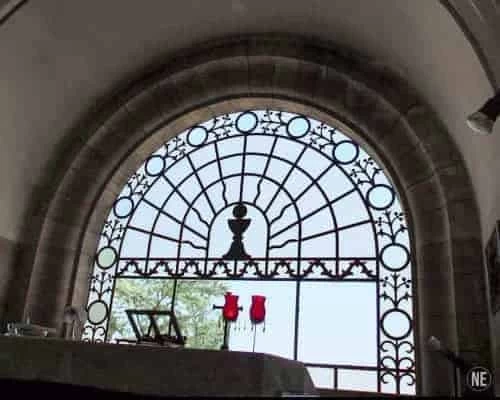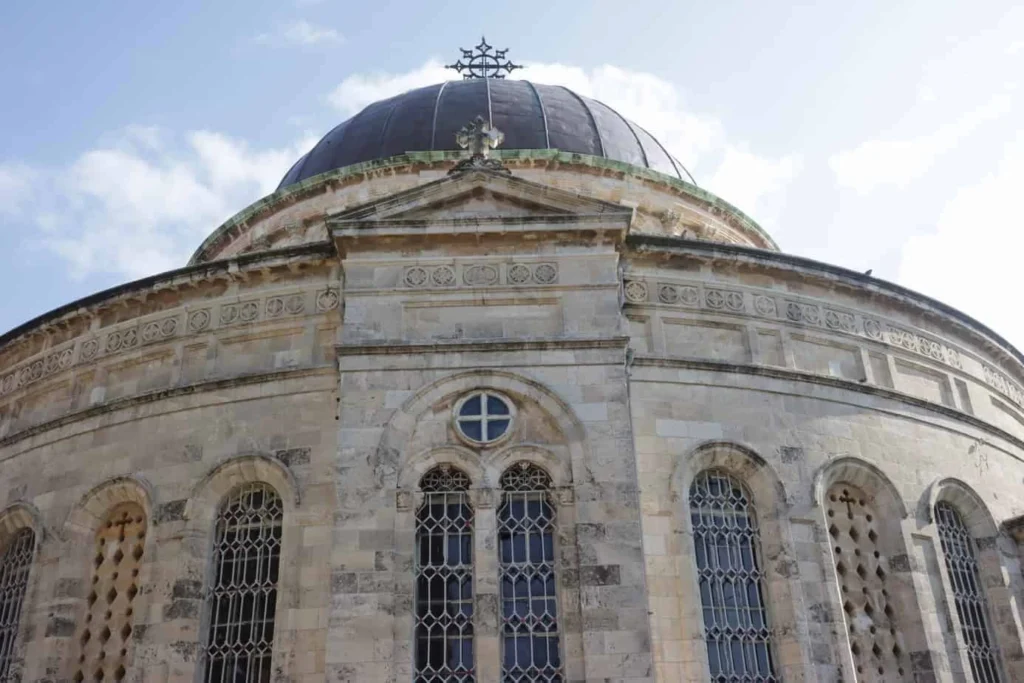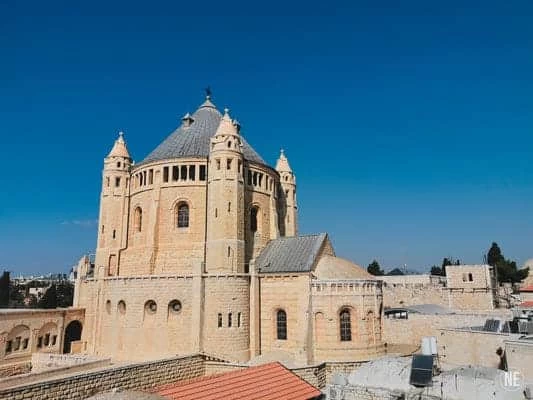This church name is in Latin and its meaning is “The Lord Wept” church and it is located in Mount Olive, Jerusalem. It symbolizes the place where Jesus rides on a donkey on Palm Sunday in Mount Olive on the way to the Temple Mount and start weeping while watching the Jewish Second Temple. He cried about the future fate of the People, as he knew that a brutal war will break out soon and will destroy Jerusalem and the entire Temple Mount. He knew that the reason for this destruction is for not recognizing him as the son of god.
(Luke 19 : 41-44)“As he approached Jerusalem and saw the city, he wept over it and said, if you, even you, had only known on this day what bring you for peace-but now it is hidden from your eyes. The days will come upon you when your enemies will build an embankment against you and encircle you and hem you in every side. They will dash you to the ground, you and the children within your walls. They will not leave once stone on another, because you did not recognize the time of god’s coming to you”

Basic Details of Dominus Flevit
Church name: Dominos Flevit
Christianity order :Catholic Roman Church (Franciscan)
Year of construction: 1955
Address: Mount Olive, Jerusalem
Opening hours:
In the Summer 8:00-12:00 am, 14:00-18:00 Pm
In the Winter 08:00-12:00 am, 14:00-17:00 pm
Phone: +972-(0)2-6266450
Map:
Building History
The architect who designed the church is the Catholic Italian architect Antonio Barluzzi who designed many churches in Israel. Established in 1955, The building reflects the story of Jesus prophecy of destruction. The church has a shape of a teardrop. This idea is also expressed in the corners of the building as there are 4 statues of bottles made of stone that represent vials of tears. In the ancient Roman world, it was customary to bring small glass vials in which the participants tears were collected and then buried with the buried. In the eastern part of the chapel, there are the remains of a mosaic from the Byzantine period from the 7th century.
Interesting design detail in this church
Since the end of the fourth century churches have been built with the altar to the east. However, Barluzzi’s altar is in the west. Berlusconi deliberately changed the location of the altar and therefore this church is one of the rare in the country and in the world that does not face east. The building faces west because that is Jerusalem, the city that was destroyed according to Jesus prophecy. Barluzzi made us think about the landscape behind the altar. Through the window one realizes that the gospel has come true, if it had not come true, we would have seen the Temple standing in front of us.
On the window are decorations of the crown of thorns, a goblet of wine with the communion bread and a cross on it. Many visitors like to photograph the cross with the Dome of the Rock in the center. If one stands just below the center of the dome and looks at the cross, it is pointing at the Church of the Holy Sepulcher.
On the west side of the dome you see a relief of Jesus on the donkey crying. On the eastern side you see a relief of the fulfillment of the prophecy with the Roman soldiers climb the walls of Jerusalem.
Arrival
| Bus lines | In Jerusalem use Bus lines No 1, 24, |
| Car | You should drive No.1 to Mount Olive Observatory, write in your waze “Olive Mountain” |
| Taxi | You can take a taxi, within Jerusalem it will cost approx. 15-60 Nis according to your location. Tell the Taxi driver you want to go to “Olive Mountain” or show him this in Hebrew תצפית הר הזיתים ומשם מעוניין לרדת בשביל, אנא הראה לי איפה לרדת לשביל לכנסיות. That way the driver will also show you where to stroll down the mountain to see the church. |
After arriving to The Mount of Olives Observatory, you should stroll down from the top of the mountain in a special road, the road where Jesus rides on Palm Sunday on a donkey. After passing over the world most ancient graveyard, you will notice on your right a sign of the Fransiscan “Jercross. This is the entrance to the Dominos Flevit church. At the entrance to the compound there is a roof over an exposed cemetery with a Jewish necropolis here with 150 different tombs.
Accessibility
for handicap can park at the entrance to the church, but there is limited space, please coordinate with the church.
Public Toilet
The are public toilets available.
Near site activities
Keep walking down the trail and you will see the Churches of Mount Olive: Russian Orthodox Mary Magdalen church and church of All Nations There is a beautiful Photographic landscape viewing the Temple mount, from the churchyard
My experience
This church is a milestone for every pilgrim who comes to the Holy Land. The church is small and intimate and allows you to identify with the story that took place here. When you walk through the pastoral courtyard, and see the impressive church building in front of the old city, you cannot ignore that the place evokes emotions.
It is possible to book here a holy mass trough the Christian Office or ask us for assistance. https://www.cicts.org/en
The colorful Byzantine mosaic floor enhances the experience of the place. The location of the altar and the window overlooking the old city, causes the church to tell the story in an original way and against the traditional architectural laws in the churches where the altar faces east. A charming, pastoral place and a must for every visitor to Jerusalem.
The Franciscan cross symbol story
When entering the gate to the church you will notice a special sign with a big cross in the middle and four crosses around it. This is the symbol of the Roman-Catholic Franciscan church. According to the story Father Francis of Assisi woke up from a dream and saw five wounds on this body: two on the hands, and other two wounds on the legs with one big wound in the center of the body. His wounds were just like Jesus wounds after he was nailed to the cross. The big wound is the middle, made by the Roman soldier who crucified Jesus to Dead to shorten his torments. Since then, according to the story, The five crosses became the symbol of the Catholic Roman church, some call this symbole “The Jerusalem Cross”.






